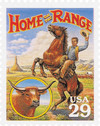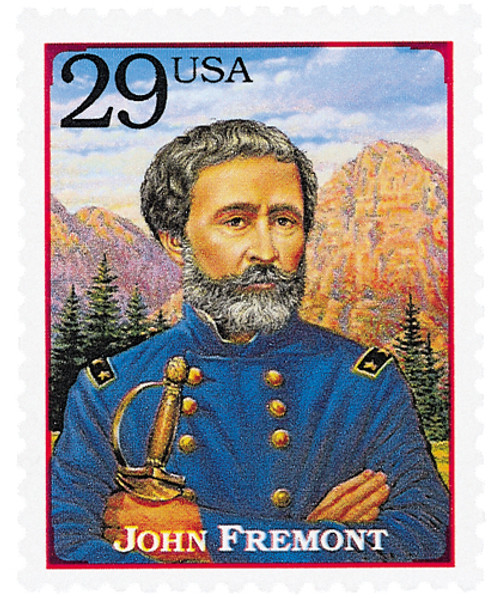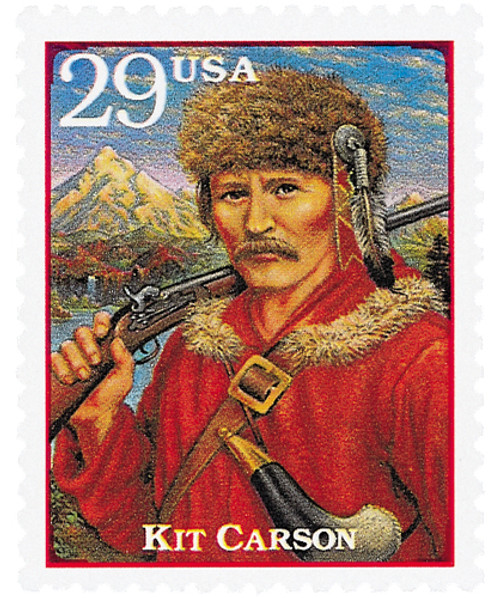
# 2869a - 1994 29c Legends of the West: Home on The Range
U.S. #2869a
1994 29¢ Home on the Range
Legends of the West
- From the corrected version of the famed Legends of the West error sheet
- First sheet in the Classic Collection Series
Stamp Category: Commemorative
Set: Legends of the West
Value: 29¢, rate for first-class mail
First Day of Issue: October 18, 1994
First Day Cities: Tucson, Arizona; Lawton, Oklahoma; Laramie, Wyoming
Quantity Issued: 19,282,800
Printed by: Stamp Venturers
Printing Method: Photogravure
Format: Panes of 20 in sheets of 120
Perforations: 10.2 x 10.1
Why the stamp was issued: The Legends of the West sheet was the first issue in the Classic Collection Series. It was developed from an idea to honor “Western Americana.”
About the stamp design: Stamp artist Mark Hess spent nearly two years working on the Legends of the West stamps. This stamp contains one of the original sketches Hess made before the stamp set was expanded to a sheet of 20. It was originally titled “Horse Handling/Cattle Herding” and was based on an old West show poster.
Special design details: This stamp comes from the famed Legends of the West sheet, which made headlines due to two mistakes made by the United States Postal Service and led to a string of events without precedent in the history of US stamp collecting.
One of the people to be featured on the sheet was black rodeo star Bill Pickett. After the stamps were announced, but not officially issued, a radio reporter phoned Frank Phillips Jr., great-grandson of Bill Pickett, and asked him about the stamp. Phillips went to his local post office, looked at the design and recognized it as Ben Pickett – Bill’s brother and business associate. The stamp pictured the wrong man! That was the first mistake.
Phillips complained to the Postal Service and Postmaster General Marvin Runyon issued an order to recall and destroy the error stamps. Runyon also ordered new revised stamps be created – these are the corrected Legends of the West stamps – #2869.
But before the recall, 186 error sheets were sold by postal workers – before the official “first day of issue.” This was the second mistake. These error sheets were being resold for sums ranging from $3,000 to $15,000 each!
Several weeks later the US Postal Service announced that 150,000 error sheets would be sold at face value by means of a mail order lottery. This unprecedented move was made with the permission of Frank Phillips Jr. so the Post Office could recover its printing cost and not lose money. Sales were limited to one per household. The remaining stamps were destroyed.
About the printing process: In order to include the text on the back of the Legends of the West stamps, it had to be printed under the gum, so that it would still be visible if a stamp was soaked off an envelope. Because people would need to lick the stamps, the ink had to be approved by the Food and Drug Administration as non-toxic. The printer also used an extra-fine 300-line screen, which resulted in some of the highest-quality gravure stamp printings in recent years.
First Day Cities: The Laramie, Wyoming First Day ceremony was held at the University of Wyoming. The Tucson, Arizona ceremony was held at the Old Tucson Studios, where the High Chaparral TV series and several Western movies had been filmed. The Lawton, Oklahoma ceremony was held at Fort Sill, where Geronimo was buried.
About the Legends of the West: The Legends of the West sheet was ultimately born out of a discussion to issue a stamp to honor the 100th anniversary of Ellis Island in 1992. That plan was abandoned, but was Ellis Island was featured on a postal card in the Historic Preservation Series (#UX165). Talks then pivoted to a stamp honoring “Western Americana.” Stamp artist Mark Hess was tasked with producing four semi-jumbo stamp images capturing the colorful and graphic look of old Wild West show posters. The Citizens Stamp Advisory Committee (CSAC) discussed Hess’ images and decided to expand on the idea and honor 16 significant men and women that played major roles in the expansion of the West. At one point, they considered outlaws such as Butch Cassidy, Billy the Kid, and Jesse James, but ultimately decided to “come down on the side of right and justice.” The sheet of 20 had a decorative header and descriptive text was included on the back of each stamp.
The Legends of the West stamp designs were also adapted to postal cards, #UX178-97.
History the stamp represents:
Home on the Range
Although the cowboy has been immortalized in American folklore, the first “cowboys” were Mexicans who did their riding and roping in the provinces of California and Texas. Calling themselves vaqueros, from the Spanish word for cow, they crafted a legacy of skills, language, and style that would live on in the American cowboy.
When Texans returned home after the Civil War, they found the plains teeming with wild longhorns. Worth $4 in Texas, a longhorn steer would fetch $40 or more back East. Soon the cattle business was booming and the cowboy became its working class. Unlike some other heroes of the West, the cowboy came by his fame honestly. He worked at a brutally hard job, tackling tasks that required agility, strength, and courage.
Riding the open range he would tend the herds of cattle, rounding them up in spring so the calves could be branded and the young bulls neutered. In the fall, the cowboys would cut the marketable steers from the herd and drive the cattle to cow towns where they were shipped East on the railroads. A major event in a cowboy’s life, the trail drive lasted 2-3 months and covered as much as 1,500 miles.
The era of the open range did not last long. By 1885, advancing homesteaders, the invention of barbed wire, and fierce blizzards brought an end to the cowboy’s way of life.
U.S. #2869a
1994 29¢ Home on the Range
Legends of the West
- From the corrected version of the famed Legends of the West error sheet
- First sheet in the Classic Collection Series
Stamp Category: Commemorative
Set: Legends of the West
Value: 29¢, rate for first-class mail
First Day of Issue: October 18, 1994
First Day Cities: Tucson, Arizona; Lawton, Oklahoma; Laramie, Wyoming
Quantity Issued: 19,282,800
Printed by: Stamp Venturers
Printing Method: Photogravure
Format: Panes of 20 in sheets of 120
Perforations: 10.2 x 10.1
Why the stamp was issued: The Legends of the West sheet was the first issue in the Classic Collection Series. It was developed from an idea to honor “Western Americana.”
About the stamp design: Stamp artist Mark Hess spent nearly two years working on the Legends of the West stamps. This stamp contains one of the original sketches Hess made before the stamp set was expanded to a sheet of 20. It was originally titled “Horse Handling/Cattle Herding” and was based on an old West show poster.
Special design details: This stamp comes from the famed Legends of the West sheet, which made headlines due to two mistakes made by the United States Postal Service and led to a string of events without precedent in the history of US stamp collecting.
One of the people to be featured on the sheet was black rodeo star Bill Pickett. After the stamps were announced, but not officially issued, a radio reporter phoned Frank Phillips Jr., great-grandson of Bill Pickett, and asked him about the stamp. Phillips went to his local post office, looked at the design and recognized it as Ben Pickett – Bill’s brother and business associate. The stamp pictured the wrong man! That was the first mistake.
Phillips complained to the Postal Service and Postmaster General Marvin Runyon issued an order to recall and destroy the error stamps. Runyon also ordered new revised stamps be created – these are the corrected Legends of the West stamps – #2869.
But before the recall, 186 error sheets were sold by postal workers – before the official “first day of issue.” This was the second mistake. These error sheets were being resold for sums ranging from $3,000 to $15,000 each!
Several weeks later the US Postal Service announced that 150,000 error sheets would be sold at face value by means of a mail order lottery. This unprecedented move was made with the permission of Frank Phillips Jr. so the Post Office could recover its printing cost and not lose money. Sales were limited to one per household. The remaining stamps were destroyed.
About the printing process: In order to include the text on the back of the Legends of the West stamps, it had to be printed under the gum, so that it would still be visible if a stamp was soaked off an envelope. Because people would need to lick the stamps, the ink had to be approved by the Food and Drug Administration as non-toxic. The printer also used an extra-fine 300-line screen, which resulted in some of the highest-quality gravure stamp printings in recent years.
First Day Cities: The Laramie, Wyoming First Day ceremony was held at the University of Wyoming. The Tucson, Arizona ceremony was held at the Old Tucson Studios, where the High Chaparral TV series and several Western movies had been filmed. The Lawton, Oklahoma ceremony was held at Fort Sill, where Geronimo was buried.
About the Legends of the West: The Legends of the West sheet was ultimately born out of a discussion to issue a stamp to honor the 100th anniversary of Ellis Island in 1992. That plan was abandoned, but was Ellis Island was featured on a postal card in the Historic Preservation Series (#UX165). Talks then pivoted to a stamp honoring “Western Americana.” Stamp artist Mark Hess was tasked with producing four semi-jumbo stamp images capturing the colorful and graphic look of old Wild West show posters. The Citizens Stamp Advisory Committee (CSAC) discussed Hess’ images and decided to expand on the idea and honor 16 significant men and women that played major roles in the expansion of the West. At one point, they considered outlaws such as Butch Cassidy, Billy the Kid, and Jesse James, but ultimately decided to “come down on the side of right and justice.” The sheet of 20 had a decorative header and descriptive text was included on the back of each stamp.
The Legends of the West stamp designs were also adapted to postal cards, #UX178-97.
History the stamp represents:
Home on the Range
Although the cowboy has been immortalized in American folklore, the first “cowboys” were Mexicans who did their riding and roping in the provinces of California and Texas. Calling themselves vaqueros, from the Spanish word for cow, they crafted a legacy of skills, language, and style that would live on in the American cowboy.
When Texans returned home after the Civil War, they found the plains teeming with wild longhorns. Worth $4 in Texas, a longhorn steer would fetch $40 or more back East. Soon the cattle business was booming and the cowboy became its working class. Unlike some other heroes of the West, the cowboy came by his fame honestly. He worked at a brutally hard job, tackling tasks that required agility, strength, and courage.
Riding the open range he would tend the herds of cattle, rounding them up in spring so the calves could be branded and the young bulls neutered. In the fall, the cowboys would cut the marketable steers from the herd and drive the cattle to cow towns where they were shipped East on the railroads. A major event in a cowboy’s life, the trail drive lasted 2-3 months and covered as much as 1,500 miles.
The era of the open range did not last long. By 1885, advancing homesteaders, the invention of barbed wire, and fierce blizzards brought an end to the cowboy’s way of life.








